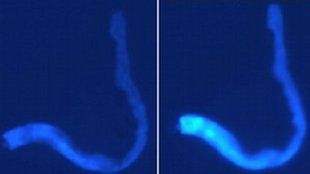Dr. Gems, University College London, and colleagues were studying aging using nematode worms. They discovered that dying nematode worms emit a wave of blue light from dying cells. It was previously thought that damaged components of aging cells collect in lysosomes forming what they call lipofuscin, which fluoresces. His team refuted that long-held belief and showed that the dying light was produced instead by anthranilate, a substance that is inactive in the acidic environment of the gut but becomes activated when cells die (necrosis) and release the substance outside the gut into a more basic environment. When they inhibited necrosis, the nematodes no longer emitted the blue fluorescence. Therefore, anthranilate appears to be a marker for necrosis. Similar waves of cell death are seen in humans during heart attacks and strokes. Therefore, insights into nematode necrosis may help researcers understand necrosis in humans as well.
Source:
C. Coburn et al., Anthranilate fluorescence marks a calcium-propagated necrotic wave that promotes organismal death in C. elegans, PLOS Biology, 11: e1001613, 2013.
- Log in to post comments

